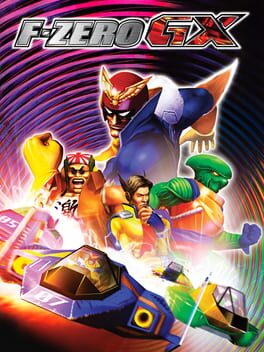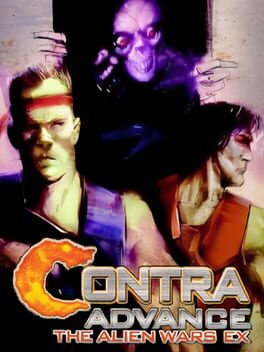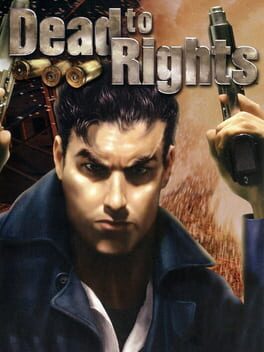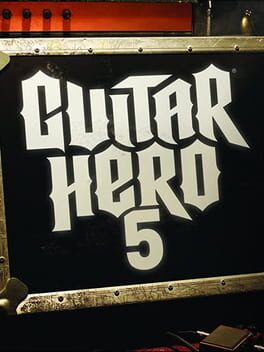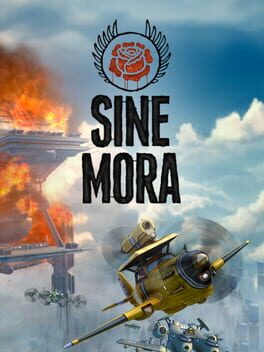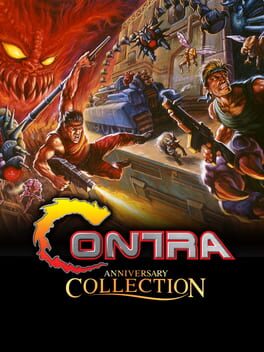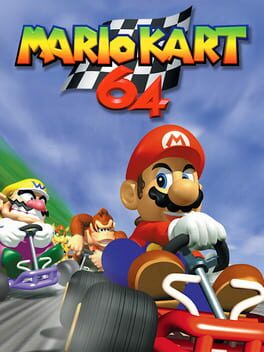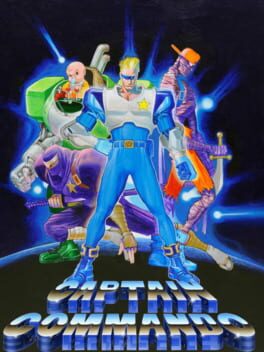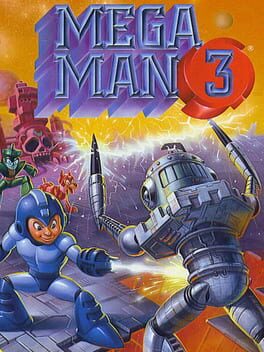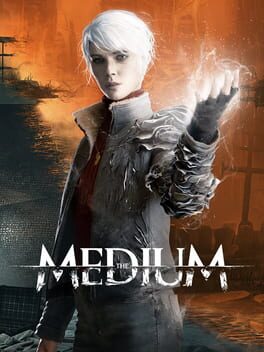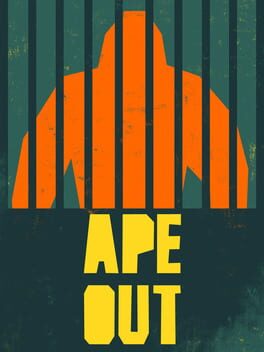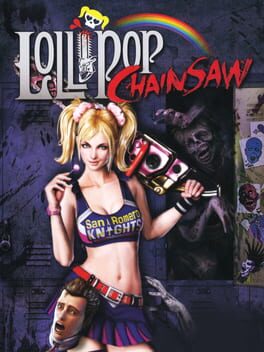2003
F-Zero GX hit everything I wanted in a racing game all at once! The gameplay, the controls, the course designs, the music, the sound effects, everything just felt so damn perfect! It's almost humiliating the way one of Nintendo's own franchises reached such a level of brilliance by the likes of SEGA!
I adored every ounce of this game, most especially how intense and difficult the racing became on higher-difficulties, asking you to hone every single essence of your elite racing skills against bot racers with an endless supply of rubber bands! The tight feeling of driving your car and every teeny-tiny movement you'd make aligning with it was incredible. This game asked for surgery-levels of precision and air-tight focus above all else.
While F-Zero X felt just right with its heavy metal vibe, the hard-hitting techno in F-Zero GX fit neatly in this futuristic hell of tall buildings and industrial venues. Looking back almost 20 years later, it's still unbelievable how well this game aged and how much of it holds up. I sometimes don't need to wonder why they haven't made a legitimate successor to this, it's basically impossible!
I adored every ounce of this game, most especially how intense and difficult the racing became on higher-difficulties, asking you to hone every single essence of your elite racing skills against bot racers with an endless supply of rubber bands! The tight feeling of driving your car and every teeny-tiny movement you'd make aligning with it was incredible. This game asked for surgery-levels of precision and air-tight focus above all else.
While F-Zero X felt just right with its heavy metal vibe, the hard-hitting techno in F-Zero GX fit neatly in this futuristic hell of tall buildings and industrial venues. Looking back almost 20 years later, it's still unbelievable how well this game aged and how much of it holds up. I sometimes don't need to wonder why they haven't made a legitimate successor to this, it's basically impossible!
A very odd quasi-remake of the original Contra 3 port on Gameboy, hence why it has such a weird name. Contra 3 was already ported to Gameboy like a decade before as Contra: The Alien Wars. But this was for the Gameboy Advance, so it added "Advanced" and "EX" to the title.
And I dig what they were going for! This wasn't just slapping a rom file into a GBA (it probably couldn't do that anyway), but instead a remake from the ground-up with crunched assets to make it palpable for the GBA's little screen.
A lot of people say the most interesting aspect is the mode-7 stages were replaced with side-scrolling stages from Contra: Hard Corps. And while that is neat in its own right, it makes for a bizarre clash in art styles since that original Genesis game looked so wildly different from its SNES predecessor. I suppose Konami didn't want to foot the bill to recreate the mode 7 stages with the GBA's 3D capabilities (yeah, the damn thing could actually render stuff in 3D, crazy right?)
Something else I think is interesting about this bite-size packaged Contra game is how they included the strafing mechanic first seen in Contra: Shattered Soldier on PS2. It kinda tells me the people involved in this little game wanted it to at least feel good to play, just a cool feature to add when they really didn't have to.
Regardless, it's an annoying, claustrophobic port of Contra 3, and I just don't really enjoy playing it. With portable gaming no longer having its own identity these days, the novelty is gone. You can buy the Anniversary Collection for next-to-nothing on Switch. You can get Nightly PCSX2 to run Shattered Soldier flawlessly on your Steam Deck. This no longer has purpose.
And I dig what they were going for! This wasn't just slapping a rom file into a GBA (it probably couldn't do that anyway), but instead a remake from the ground-up with crunched assets to make it palpable for the GBA's little screen.
A lot of people say the most interesting aspect is the mode-7 stages were replaced with side-scrolling stages from Contra: Hard Corps. And while that is neat in its own right, it makes for a bizarre clash in art styles since that original Genesis game looked so wildly different from its SNES predecessor. I suppose Konami didn't want to foot the bill to recreate the mode 7 stages with the GBA's 3D capabilities (yeah, the damn thing could actually render stuff in 3D, crazy right?)
Something else I think is interesting about this bite-size packaged Contra game is how they included the strafing mechanic first seen in Contra: Shattered Soldier on PS2. It kinda tells me the people involved in this little game wanted it to at least feel good to play, just a cool feature to add when they really didn't have to.
Regardless, it's an annoying, claustrophobic port of Contra 3, and I just don't really enjoy playing it. With portable gaming no longer having its own identity these days, the novelty is gone. You can buy the Anniversary Collection for next-to-nothing on Switch. You can get Nightly PCSX2 to run Shattered Soldier flawlessly on your Steam Deck. This no longer has purpose.
2002
Among the various games that heavily derived from Max Payne's rumbling entrance with its gritty third-person shooter-focused combat, Dead to Rights is probably the best one. It's a pretty simple game that stands out with its quirks and diverse pace-breaking sections that require you to disarm bombs, jimmy-open doors, etc. Also, the unique mechanic of sending out your dog to maul unsuspecting goons and create new paths for our armed protagonist are also fun and add more diversity to the gameplay.
The story isn't exactly groundbreaking either, but it sets the mood right as a tale of pure revenge that sets Jack Slate on a path that unveils crooked capitalists and citywide plans of corruption and greed . . . huh, that all sounds a little too familiar.
Overall, the gunplay is really satisfying, it always encourages you to act fast and tear through your enemies, and its lock-on function is more than handy. Some of the mini-games stay their welcome a little too long at times, though. This all made for a fun package when I was just a teenager craving more gritty goodness, but these days I won't argue when someone describes how unremarkable it is these days.
The story isn't exactly groundbreaking either, but it sets the mood right as a tale of pure revenge that sets Jack Slate on a path that unveils crooked capitalists and citywide plans of corruption and greed . . . huh, that all sounds a little too familiar.
Overall, the gunplay is really satisfying, it always encourages you to act fast and tear through your enemies, and its lock-on function is more than handy. Some of the mini-games stay their welcome a little too long at times, though. This all made for a fun package when I was just a teenager craving more gritty goodness, but these days I won't argue when someone describes how unremarkable it is these days.
2007
A good little overhead car combat-ish game by the veterns behind the original Twisted Metal games. Calling All Cars has some charm to it, and the game feels damn good to play! I just think as a whole package it felt a bit lacking. It continues to be shunned as one of those early PS3 download-only games.
It's sitting in a pile of a whole bunch of other IPs Sony fully-owns but never ported to anything else, thus rotting in its obscurity. Why games like Dead Nation can continue to live onward on PS4/5 but this remains inside PS3's download-only hell is beyond me.
It's sitting in a pile of a whole bunch of other IPs Sony fully-owns but never ported to anything else, thus rotting in its obscurity. Why games like Dead Nation can continue to live onward on PS4/5 but this remains inside PS3's download-only hell is beyond me.
2009
A rhythm game that was so shitty, Courtney Love sued Activision over it. No wait, it's because they let the Kurt Cobain model be utilized for any song, not just the Nirvana tracks.
I'm not going to give Guitar Hero 5 points for "playing just fine" since it changed literally none of its format from 4. That work was already done for them. The visual aspect is so lacking and oddly dark, and all the guest appearances feel pathetically hollow, more so than in the previous game.
I'm not going to give Guitar Hero 5 points for "playing just fine" since it changed literally none of its format from 4. That work was already done for them. The visual aspect is so lacking and oddly dark, and all the guest appearances feel pathetically hollow, more so than in the previous game.
2012
A pretty good shmup with tough patterns and gratifying weapons. The large enemy designs are also pretty charming, and I'm kind of a sucker for andromorphic characters that look groaty and disheveled. It makes them feel more real, if that makes sense. The story they carry is also mildly interesting, with gripping bits here and there. I also like that they kept the original Hungarian voice-acting.
The challenge of the bosses and their projectile trajectory is the real meat, and the game's story mode is pretty lenient with its continues and checkpoints. Apparently diagonal bullets are considered bad faux pas, but I wouldn't really know, this is not my subgenre at all.
The atmosphere is what helps me remember this game, goes for a good tech-y steampunk vibe, and Akira Yamaoka's contributions as head composer shine throughout.
The challenge of the bosses and their projectile trajectory is the real meat, and the game's story mode is pretty lenient with its continues and checkpoints. Apparently diagonal bullets are considered bad faux pas, but I wouldn't really know, this is not my subgenre at all.
The atmosphere is what helps me remember this game, goes for a good tech-y steampunk vibe, and Akira Yamaoka's contributions as head composer shine throughout.
This review doesn't have anything to do with the quality of each game, and I've actually reviewed them all separately on this site. This is more in regards to the collection itself and its presentation.
For the absolute bare minimum a port collection needs to be, it clears it perfectly well. This is the least I expect from M2, who are absolute porting wizards. I also appreciate the inclusion of the Japanese and European 'Probotector' versions of their respective games, as well as making said EU versions 60hz in order to make these games function the way they were supposed to. And as someone that doesn't agree with the notion of a rewind function being necessary for ports of 2D games, I'm perfectly satisfied without it. If I really want to practice a stage, the single save state they provide for each game is enough for me.
Regarding extras, it isn't anything groundbreaking, but the extensive interview with Nobuya Nakazato was greatly appreciated! He may not be the creator of Contra, but he IS the reason it evolved into an action-packed run-n-gun monster, being the director of Contra 3, Contra Hard Corps, and Contra Shattered Soldier! His insight and look back on these games was very refreshing, and I'm happy to see he's still active and thinking about Contra.
A complaint I have is the fact that Contra Hard Corps' controls weren't changed at all. I know it just takes getting used to, believe me. I've legitimately cleared the game multiple times with no save states. But it's hard when the majority of the games in this series are closest to Contra 3, a game that utilized a 6-button pad. M2 has been known to tweak and improve small things in the games they're porting/remastering, so I wish they were able to do something in that regard. Of course, it could be a deep level of programming I don't understand being the reason it wasn't possible under them. So I won't give them much flack.
One more complaint--and something I do find necessary for these collections--is the cover art. I think they should always bare a new cover art celebrating the history of whatever game it's a collection for, whether it be a new artist or previous returning. Instead, they just used the Tom DuBois piece from Contra 3's US cover. However, a new cover WAS made . . . for the Limited Run release. Fuck Limited Run. Thanks for reading.
For the absolute bare minimum a port collection needs to be, it clears it perfectly well. This is the least I expect from M2, who are absolute porting wizards. I also appreciate the inclusion of the Japanese and European 'Probotector' versions of their respective games, as well as making said EU versions 60hz in order to make these games function the way they were supposed to. And as someone that doesn't agree with the notion of a rewind function being necessary for ports of 2D games, I'm perfectly satisfied without it. If I really want to practice a stage, the single save state they provide for each game is enough for me.
Regarding extras, it isn't anything groundbreaking, but the extensive interview with Nobuya Nakazato was greatly appreciated! He may not be the creator of Contra, but he IS the reason it evolved into an action-packed run-n-gun monster, being the director of Contra 3, Contra Hard Corps, and Contra Shattered Soldier! His insight and look back on these games was very refreshing, and I'm happy to see he's still active and thinking about Contra.
A complaint I have is the fact that Contra Hard Corps' controls weren't changed at all. I know it just takes getting used to, believe me. I've legitimately cleared the game multiple times with no save states. But it's hard when the majority of the games in this series are closest to Contra 3, a game that utilized a 6-button pad. M2 has been known to tweak and improve small things in the games they're porting/remastering, so I wish they were able to do something in that regard. Of course, it could be a deep level of programming I don't understand being the reason it wasn't possible under them. So I won't give them much flack.
One more complaint--and something I do find necessary for these collections--is the cover art. I think they should always bare a new cover art celebrating the history of whatever game it's a collection for, whether it be a new artist or previous returning. Instead, they just used the Tom DuBois piece from Contra 3's US cover. However, a new cover WAS made . . . for the Limited Run release. Fuck Limited Run. Thanks for reading.
1996
Loved it as a kid, but looking back, how on Earth did I deal with this game's design so much? I have such specific memories of clearing everything at 150cc as well as mirror mode, but now I struggle to even get 1st place in most 100cc races. It probably comes from playing the modern titles that have barely changed its core design/mechanics since 2008.
The merge between 2D sprites and 3D venues was done nicely as a smart way to save on resources that didn't feel off-putting in the slightest. I like how much the game calls for precision, it's no wonder this started forming the competitive aspect between players all the way back in the late 90s.
It's just hard to go back to these days. And I wouldn't even say the game aged (I don't believe in that notion), we just became so accustomed to a different kind of design from this same series afterward. Mario Kart 64 has much more in common with its predecessor than it does with all the mainline entries afterward . . . I can still get that giant Rainbow Road shortcut like a champ tho.
The merge between 2D sprites and 3D venues was done nicely as a smart way to save on resources that didn't feel off-putting in the slightest. I like how much the game calls for precision, it's no wonder this started forming the competitive aspect between players all the way back in the late 90s.
It's just hard to go back to these days. And I wouldn't even say the game aged (I don't believe in that notion), we just became so accustomed to a different kind of design from this same series afterward. Mario Kart 64 has much more in common with its predecessor than it does with all the mainline entries afterward . . . I can still get that giant Rainbow Road shortcut like a champ tho.
This was an okay game to play through with friends on discord whilst staving cabin fever during the early stages of the pandemic. However, even for its small scale, it just feels unimaginative and unoriginal for the most part. I appreciate the concept a lot, it's why my friends and I wanted to play it!
There's a couple scares that are fun, but overall it's just kind of boring. I feel the game doesn't take enough advantage of the atmosphere provided, most especially the living space of the main character that can be particularly scary. The character models look like absolute shit, but I get not wanting to just use pre-existing models from an Unreal store or whatever.
Also, as someone that stayed in Japan for about a month and lived off the numerous Family Marts and such, this looks NOTHING like a Japanese convenience store. The design and shelves look particularly American.
There's a couple scares that are fun, but overall it's just kind of boring. I feel the game doesn't take enough advantage of the atmosphere provided, most especially the living space of the main character that can be particularly scary. The character models look like absolute shit, but I get not wanting to just use pre-existing models from an Unreal store or whatever.
Also, as someone that stayed in Japan for about a month and lived off the numerous Family Marts and such, this looks NOTHING like a Japanese convenience store. The design and shelves look particularly American.
1993
A Sonic game that was able to expand some of its limitations, thanks to utilizing the Sega CD add-on. This granted more animation frames for Sonic, higher quality music, and much larger stages. The latter is the most detrimental aspect, in my opinion, and that's because they seemingly designed this game to be more about exploring the stages, rather than clearing the course as quickly as you can.
I personally did not enjoy this aspect of the level design, and it really ruins a lot of the fun I could potentially be having with what is otherwise a 2D Sonic game that feels good to play that also boasts great animation and music. The boss fights also feel lackluster, most especially the final boss. Racing Metal Sonic was the most exciting the game got for me.
I personally did not enjoy this aspect of the level design, and it really ruins a lot of the fun I could potentially be having with what is otherwise a 2D Sonic game that feels good to play that also boasts great animation and music. The boss fights also feel lackluster, most especially the final boss. Racing Metal Sonic was the most exciting the game got for me.
1991
A classic Capcom beat-em-up that has just about all the same shortcomings as Final Fight, but its personality and expanded vision helps it stand out.
For one thing, the perspective of the game is noticeably farther, making the stages bigger and easier to see the enemies coming to better-plan your next moves. It also allows up to 4 players, but unsurprisingly this leads to pure chaos where you barely have any idea what's going on half the time.
I also like the surprising amount of violence the game has. Using the various characters, you can burn your enemies alive, turn them into bones, or even slice them in half! It makes the knock-outs more gratifying when they unexpectedly receive a brutal death. Even your own characters can be split in half from blade-wielding enemies! That's awesome.
Captain Commando has a lot of 90s Superhero charm to go around, and has a unique taste to it as well. I'm surprised they never really tried to capitalize on the style this game provided outside of guest appearances.
For one thing, the perspective of the game is noticeably farther, making the stages bigger and easier to see the enemies coming to better-plan your next moves. It also allows up to 4 players, but unsurprisingly this leads to pure chaos where you barely have any idea what's going on half the time.
I also like the surprising amount of violence the game has. Using the various characters, you can burn your enemies alive, turn them into bones, or even slice them in half! It makes the knock-outs more gratifying when they unexpectedly receive a brutal death. Even your own characters can be split in half from blade-wielding enemies! That's awesome.
Captain Commando has a lot of 90s Superhero charm to go around, and has a unique taste to it as well. I'm surprised they never really tried to capitalize on the style this game provided outside of guest appearances.
1990
This riveting sequel to Mega Man 2 adds the amazing ability to . . . slide. And hey, it's pretty useful. It makes for clutch moves that avoid enemy fire, especially considering Mega Man was still unable to duck.
Besides that, it's hard to even say what it did different from Mega Man 2. The level design continues to be pretty competent, but it loses a lot of good faith with the endgame stages. You're going to make me fight spiritual clones of the Mega Man 2 robot masters who all have new weaknesses, AND rematch the Mega Man 3 bosses? That shit was so boring and made the near-end of the game a drag to finish.
Besides that, it's hard to even say what it did different from Mega Man 2. The level design continues to be pretty competent, but it loses a lot of good faith with the endgame stages. You're going to make me fight spiritual clones of the Mega Man 2 robot masters who all have new weaknesses, AND rematch the Mega Man 3 bosses? That shit was so boring and made the near-end of the game a drag to finish.
2021
2019
An ape has escaped from captivity in some big building, and the employees' solution was shotguns, SMGs, flamethrowers, grenade launchers, AIR RAID BOMBS . . . humanity, what the fuck is your problem?
Anyway, music rocks, visuals are great, clearing stages feels good as hell, it's a primo example of a dope-ass indie game. I also like that the title is the end of each sequence. You get that APE OUT.
Anyway, music rocks, visuals are great, clearing stages feels good as hell, it's a primo example of a dope-ass indie game. I also like that the title is the end of each sequence. You get that APE OUT.
2012
A hack-n-slash game that emphasizes on the hacking, which I find appropriate, considering an oversized chainsaw is the primary weapon. Lollipop Chainsaw is a cheeky action game that's humorous and creative in its own fun ways, but leans a bit too heavily on references in lieu of clever comedy. Not that the game isn't funny at times. The gameplay itself is a bit monotonous as well, rarely will it ask you to be strategic with your ways of attacking, and their way of congratulating the player with multi-kills really start to feel like punishment when you've refined your methods to group-up and kill.
The game has plenty of highlights too, I adore the concept of the zombies not just being able to talk, but also talk shit. A lot of their weird little lines and cadence are a delight. The music is also pretty fantastic, specifically the non-licensed tracks. Akira Yamaoka did a fine job providing more of this whacky punk atmosphere, and Jimmy Urine's boss tracks stand out the most, as they should.
Even so, it's a repetitive game that doesn't do a lot asking for replays. The most interesting thing about this game, to me, is seeing it in the lens of sexism. I personally think this game is trying to say some curious things about sexist roles in fantasy. The fact that the roles between the main male and female characters have been reversed from its norm (Nick literally becoming an "object" that's mocked and ogled for his appearance) says plenty, and I like how Juliet isn't exactly a perfect character either, showing her flaws throughout the game.
In other words, Lollipop Chainsaw is a good example of bait-n-switch in the world of power fantasies, but I think the eye candy is a little too in-your-face that I don't blame people for not seeing the game in the same light as I do.
The game has plenty of highlights too, I adore the concept of the zombies not just being able to talk, but also talk shit. A lot of their weird little lines and cadence are a delight. The music is also pretty fantastic, specifically the non-licensed tracks. Akira Yamaoka did a fine job providing more of this whacky punk atmosphere, and Jimmy Urine's boss tracks stand out the most, as they should.
Even so, it's a repetitive game that doesn't do a lot asking for replays. The most interesting thing about this game, to me, is seeing it in the lens of sexism. I personally think this game is trying to say some curious things about sexist roles in fantasy. The fact that the roles between the main male and female characters have been reversed from its norm (Nick literally becoming an "object" that's mocked and ogled for his appearance) says plenty, and I like how Juliet isn't exactly a perfect character either, showing her flaws throughout the game.
In other words, Lollipop Chainsaw is a good example of bait-n-switch in the world of power fantasies, but I think the eye candy is a little too in-your-face that I don't blame people for not seeing the game in the same light as I do.
